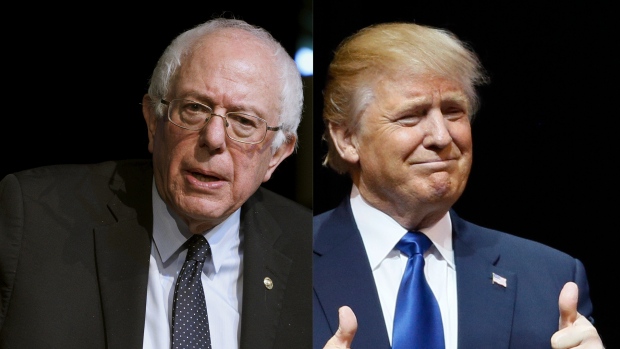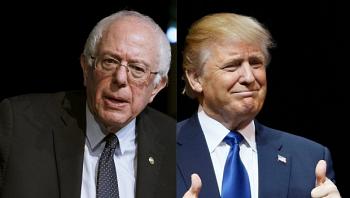Why we have to talk about Hitler when we discuss Trump and Sanders: Don Pittis
Godwin's law, also sometimes known as the Hitler rule, states that eventually, all protracted arguments, especially on the internet, end up with the introduction of an analogy to Hitler and Nazi Germany — the ultimate sign that they have gone too far.
But despite the warning implied by the rule — first proposed by Mike Godwin, author of Cyber Rights: Defending Free Speech in the Digital Age — it remains useful to apply lessons from Europe's interwar period to what is happening in the current U.S. presidential election campaign.
- Barack Obama thanks Cape Breton for welcoming Americans fleeing Donald Trump
- Donald Trump welcomes Ben Carson endorsement
Interfactional violence that forced the cancellation of a Trump rally in Chicago on Friday night was certainly a worrying sign that something is happening outside of what we think of as the run-of-the-mill American electoral process.
Photographs of a woman wearing a Trump T-shirt giving an unmistakable Nazi raised-arm salute have only increased the tension. Her confusing explanation cannot remove the visceral impact of that image, something bound to further polarize an election marked by clashing ideologies.
There had already been comparisons, even in the most credible of media, between Donald Trump and the Nazis, but the details of the Republican front-runner's anti-Muslim views and wild statements labelling immigrants rapists are only incidental to a much more important phenomenon that includes Democratic presidential candidate Bernie Sanders, too.
Nazi allusions
Certainly, stories in the mainstream media have not shied away from associating Trump with Adolf Hitler. USA Today and the Financial Times have made explicit Nazi allusions.

Election campaigns are always full of strong partisan views, but supporters of both Sanders and Trump are united in their desire to discredit Democratic presidential front-runner Hillary Clinton as a representative of the status quo political elite. (Reuters)
Even before the Friday night incident, The Economist made reference to "a fascist-style salute," ostensibly made by Trump's supporters in Florida last week as he was asking them to pledge to vote for him. Since then, the notion of any similarity has been discredited, including by well-known U.S. rabbi and broadcaster Mark Golub.
"To suggest that Donald Trump mimicked Adolf Hitler is to totally undermine and to trivialize the horrific evil that Adolf Hitler was," said Golub.
A polarized dispute
Apart from efforts by political opponents to identify their enemy with the modern personification of ultimate evil, there is another reason to compare the current polarized U.S. election campaign with Europe after the First World War.
While the period did, eventually, see the Nazi regime come to power, according to Hitler biographer Ian Kershaw, there was nothing inevitable about it.

Some commentators interpreted hands raised in a pledge to vote for Trump last week in Florida as a Nazi salute, but video of the event showed something much more innocuous. (The Associated Press)
At the time, all of Europe was in turmoil. Long-held conventions of the social order had collapsed. Perhaps most important, the economy was in chaos, especially in Germany.
What had been a stable, confident economic system with sound banking, full employment, pensions for workers and universal education was torn apart by the Great War.
Even as they pitched out the Kaiser and increased the power of the country's parliamentary system, Germans knew the economy wasn't working. They just didn't know how to fix it.
No easy answers
I only read Kershaw's 1,000-page brick last month after seeing it recommended. It was sort of by mistake, because I ordered it from the library as my subway reading without realizing what a monster it would be to lug around.
One of the most fascinating revelations in it was how completely unlikely it was that Hitler would ever come to power. When it was formed, his National Socialist German Workers' Party was only one of many political groups of the left and right and by no means the largest.

Sanders, left, raises a clenched fist, a strong symbol of leftist opposition. Sanders sits as an Independent in the U.S. Senate but is running as a Democrat in the presidential nomination race. (Reuters)
While the duly elected government struggled to get the economy back on track, mainstream leaders were increasingly seen as helpless or indecisive or merely perpetuating the unacceptable status quo.
The country's voters knew what they wanted. They wanted a return to the good times they had had before the war. They wanted jobs and good food. They wanted their pride back. They wanted to make Germany great again.
The deadly political battle that ensued was not because they ultimately wanted different things, but because each tiny faction had a different idea about how to get there. Not really knowing what was wrong, they became increasingly angry and chose different enemies to blame. As they fought it out and became more extreme, the various factions coalesced into two polar opposites.

Support from the Ku Klux Klan and statements villifying immigrants have opened Trump up to charges of racism in what is becoming an increasingly polarized election campaign. (Reuters)
"We confirm the existence of a link between political extremism and economic hard times as captured by growth or contraction of the economy," concluded a group of economists from the University of Oxford and the University of California, Berkeley.
Their 2012 study — whose findings were uncontaminated by the current presidential race — specifically focuses on the rise of right wing "anti-system" parties during the Great Depression. But it found that extremists of all stripes did better in countries where democracy was new or weak.
America's saving grace
And this may be the lesson of the analogy and at the same time the saving grace of the American political system.
A large group, probably a majority, of Americans are dissatisfied with the current state of affairs. America is not the power it once was. Americans used to be rich, with good working-class jobs and a robust middle class.
American voters want those days back, but voting for traditional leaders has not done the trick, because with the best will in the world, there is no easy solution.
'So long as the disenchantment continues without solution, the polarization will continue, too.' - Don Pittis
In hope of finding a way back to the golden age, voters have begun to polarize around two different sets of solutions with different groups being assigned the blame. But just as the time between the wars, whether or not extreme solutions at either pole will solve the current economic problems in the long term remains a crap shoot.
Of course, despite a few similarities, the differences between the eras and the players remain huge. But so long as the disenchantment continues without solution, the polarization will continue, too.
Unlike in interwar Germany, the U.S. dispute, while polarized, remains firmly within a long and vibrant democratic tradition, a very good thing in a country whose citizens are armed to the teeth.
If the U.S. wants to avoid what happened in Germany, it is essential that the United States remain within that strong political tradition, and no matter how heated and polarized the debate becomes, that everyone in the country continues to honour their democratic institutions. So long as they don't carry things too far, they will come out the other side even stronger.
Follow Don on Twitter @don_pittis
Comments
There are 0 comments on this post













